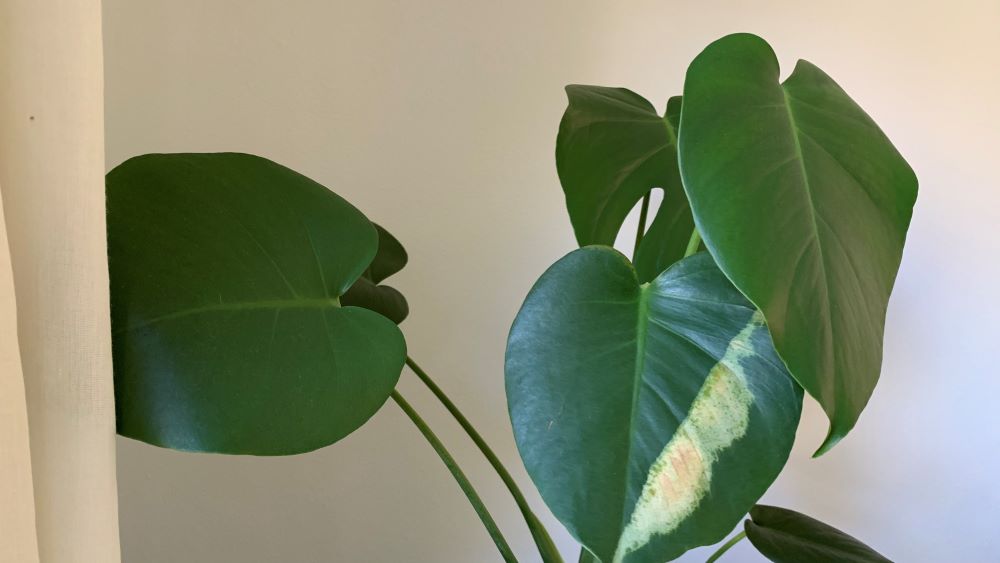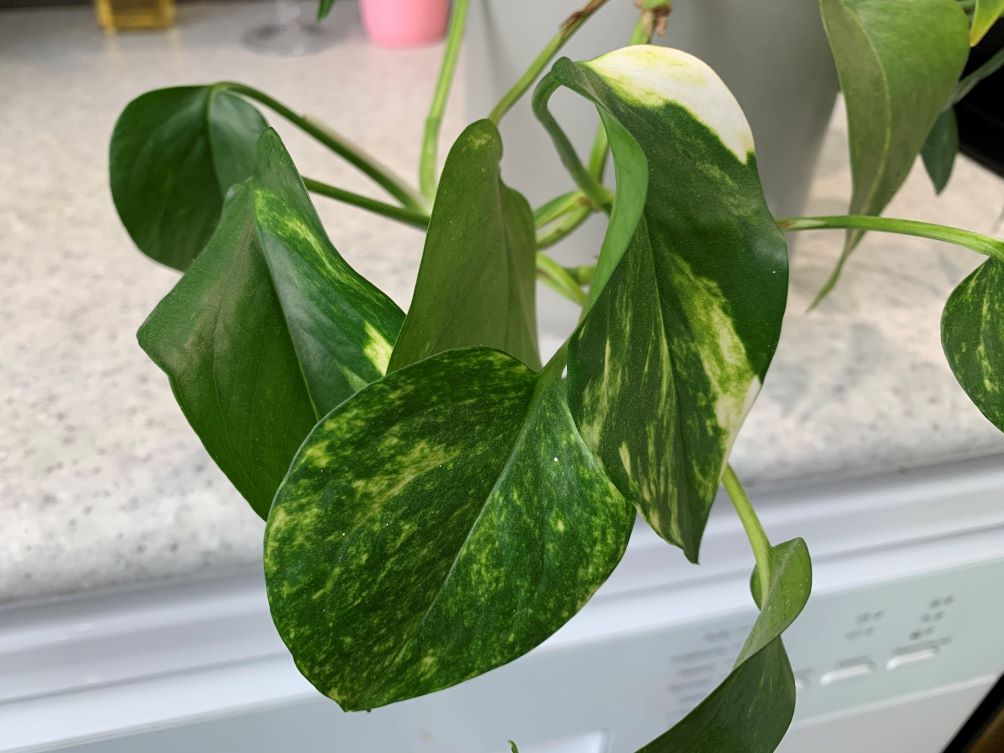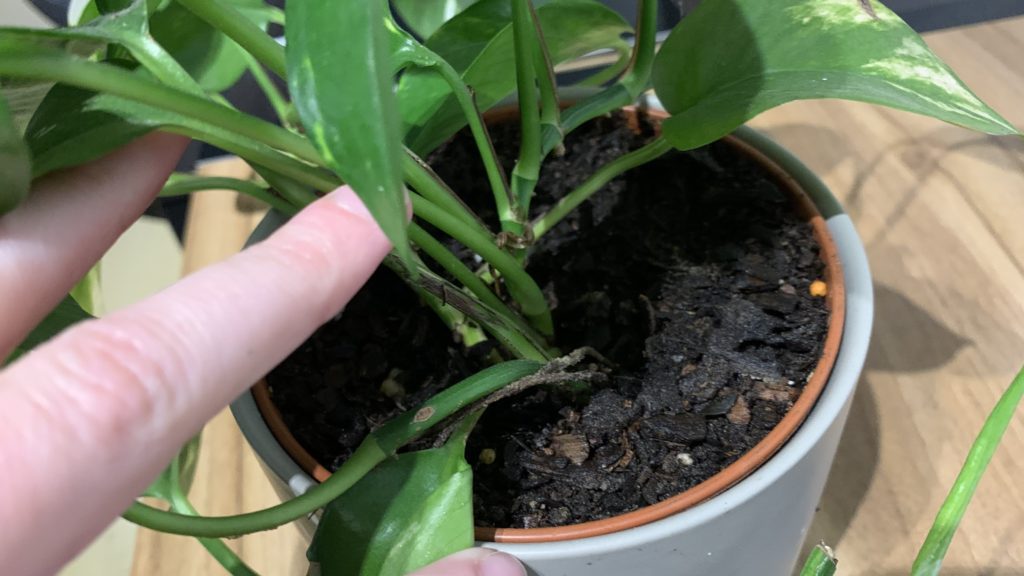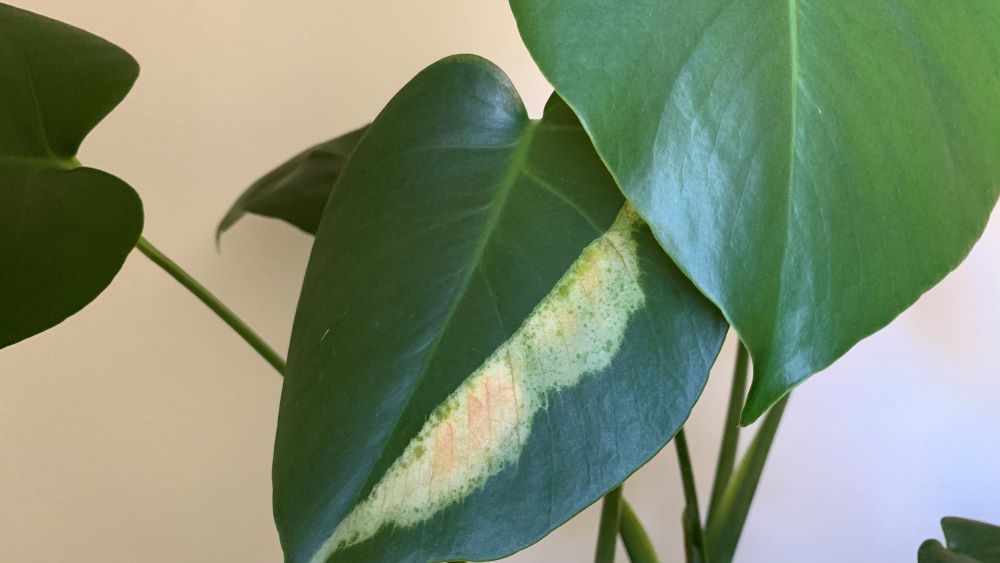Drooping leaves on your plant are a sign of both overwatering and underwatering. The simplest way to tell the difference is to look at the soil. If the soil is wet it is overwatered if it looks dry it is underwatered. You can also look out for a range of signs which can tell you the difference including black marks, mold and brown leaf edges.
This article will explore the signs of overwatering and underwatering and how you can tell the difference between the two.

1. Black marks on leaves
Overwatered plants
Indoor plants like monstera will show signs of overwatering by developing black marks on their leaves. ZZ plants can also develop dark brown and black spots on their leaves and stems if they get too much water.
As the leaf tissue is damaged it will turn a dark black color which is a sign the plant has too much water. Slow down your watering schedule, allow your plant to drain well and move it into a bright position to help it to dry out quicker.
Underwatered plants
Underwatered plants will only develop black or dark spots if they are affected by pests or fungus. This will can look like a small and round dot or even a fuzzy black mold growth.
2. Drooping leaves
Both over and underwatered plants can develop drooping the leaves. The way to tell the difference is to feel the leaves.

Overwatered plants
An overwatered plant will have soft, supple leaves that curl inwards. To be certain that overwatered is the problem feel and check the soil. If the soil is wet and soggy then overwatering is most likely to be the problem. Allow the plant to dry out and the leaves can recover in 1-2 weeks.
Underwatered plants
Underwatered plants will have harder, crispier leaves. The other thing to check is the soil. Stick your finger in the top of the soil and if it is dry 1-2 inches down then the problem is not enough water.
2. Mold on the surface of the soil

Overwatered
Mold growing on the surface of the soil is usually a good sign the plant is overwatered. The mold could be white or gray and sit on the surface on the soil. The soil will usually look wet which supports the mold growth. The mold won’t hurt the plant but it is a sign that the soil needs more time to dry before watering again.
Underwatered
Mold will rarely form on an underwatered or dry plant. Sometimes potting soil can look white if it is allowed to dry out but you will notice the soil will turn dark again when you water the plant.
3. Brown marks on leaves

Overwatered
Brown marks can form on the leaves as the second stage after black marks. My monstera was overwatered and developed black marks which then turned brown. As the leaf recovered the leaf healed itself leaving a brown mark.
The brown marks on an overwatered plant can form in the center of the leaf as well as the edges. The leaf will feel soft and can droop.
Underwatered
A plant that is underwatered can develop brown leaf edges. The leaf will feel dry and crispy and the brown color can extend down the stem.
Once a leaf has turned brown it will not recover. While the rest of the leaf can stay green the brown patch will stay brown. To tidy up indoor plants, simply trim off brown and damaged leaves with scissors or secateurs.
4. Water in the base of the outer pot or pot tray.

Overwatered
To see if your plant may be overwatered check the base of the outer pot or the pot tray. If there is constantly water sitting in the bottom there is a good chance your plant is overwatered. Once the soil becomes saturated it will not absorb any more water and the rest will sit at the bottom.
This excess water can damage the roots, cause fungal growth or root rot and drooping leaves.
5. Rotting roots

Overwatered plants can develop root rot which is a fungal growth that can damage the roots. The roots can turn black or brown and will stop absorbing the water and nutrients the plant needs. This can lead to drooping, brown and yellowing leaves.
It can take weeks of overwatering before the plant develops root rot but it is important to act fast when it happens. I like to repot my plants if their roots are damaged to give them fresh soil and new nutrients. This will add back the air to the soil so the roots can recover.
6. Yellowing leaves

Overwatered
Yellow leaves can develop when the plant has been overwatered. Extra water can wash away nitrogen and damage the plant roots. All of these factors can lead to yellowing leaves. When the plant is not getting enough nitrogen it will not develop the chlorophyll in its leaves which gives them the green color.
Underwatered
Underwatered plants can also develop yellow leaves. As leaves dry out they usually turn yellow and then brown. After they have turned yellow the leaves will not recover so you can trim them off. Deep water your plant with some dilute seaweed solution
How to fix underwatered plants
Underwatered plants can be saved by deep watering. You can submerge the whole pot in a bucket of water until the water level is just below the top of the pot. Let it soak in the water for 5-10 minutes to fully hydrate the soil.
Take the pot out and let it drain. You can even add a dash of seaweed solution to the water to help the plant roots to recover quicker.
How to fix overwatered plants
To fix an overwatered plant that has started to droop you can leave it for 1-2 weeks to dry out on its own. You can also take more active measures to dry out the plant quicker including placing it near a bright window, under a ceiling fan or even repot with new soil.
For very soggy or moldy soil it is usually best to repot the plant. Let the old soil drop off naturally and replace it with new, fresh soil. Water the plant in gently to settle the soil in and water again after 1-2 weeks or when the soil has dried out.
For more on how to fix overwatered plants, check out my previous article here, How to dry out overwatered indoor plants | 5 Easy Ways.
How to Tell if a Plant is Overwatered or Underwatered | Summary
To tell the difference between an overwatered or underwatered plant look for signs on the leaves, soil and stems. Overwatered plants will usually have drooping leaves with brown or black marks in the middle parts of the leaves. The soil will be wet and soggy and can even grow mold.
Underwatered plants can have droopy leaves with brown edges, yellowing and the soil surface will look very dry. Deep watering can solve this problem if you catch it soon enough.
Happy growing.
I am an accredited practicing dietitian, experienced gardener and a dedicated cook. I love writing and sharing my experience so you can learn from my successes and mistakes.
